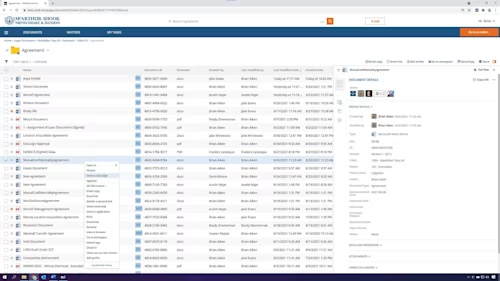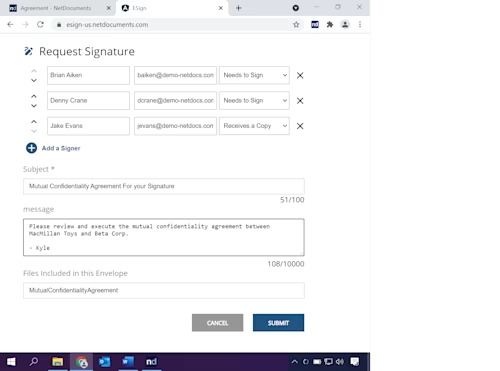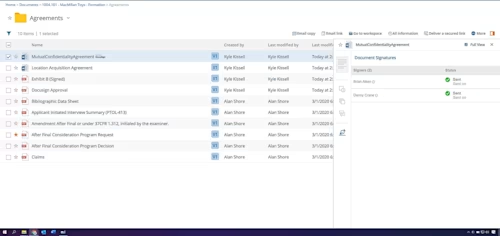
NetDocuments wins the case for their customers by integrating with the Docusign eSignature REST API
NetDocuments' Docusign integration saves their legal clients time and improves document security.


“Lawyers want a seamless workflow that connects drafting, executing, and saving signed agreements back into the client file. NetDocuments’ integration with Docusign makes that possible. ” — Dan Hauck, Chief Product Officer, NetDocuments
NetDocuments, a Docusign Partner, offers a cloud-first legal content management service. Among other products, the platform provides a repository for customers to store, manage, and collaborate on legal documents. Thousands of law firms and corporate legal departments around the world trust NetDocuments to secure their documents, emails, and more.
The case for Docusign
Before developing the integration, NetDocuments knew that eSignature functionality was a key next step for their product. Signatures are often essential for legal documents such as contracts, agreements, engagement letters, and more. In fact, many NetDocuments customers were already using Docusign even before it was integrated into the platform. For example, a lawyer using NetDocuments might have a contract that needed to be signed by a third party. The lawyer would download the document from NetDocuments, upload it to Docusign, send it for signing, download the executed document, and re-upload it to NetDocuments. This process was not only cumbersome. Requiring the lawyer to download the document also contradicted one of NetDocuments’ key value propositions: to ensure security and best governance practices, the journey of a document should be cloud-first.
When the NetDocuments team decided to implement eSignature capabilities into the platform, they looked at several different options. Docusign was the clear choice. Besides being the leading eSignature platform, Docusign was already used and trusted by NetDocuments customers. As product manager Fred Levesque explained, “Even in January of 2020 when we were just shopping this around with customers, it was just such a strong reaction and clear value-add on both sides.”
Raising the bar
The NetDocuments document management platform is organized hierarchically. Each client’s repository is divided into categories called workspaces, which contain various matters. A matter represents a single project, such as a transaction or contract negotiation, and contains multiple documents. Customers can enable the Docusign integration at the workspace level.
To enable users to interact with Docusign within NetDocuments, the engineering team implemented Docusign’s embedded signing model. From any matter that has the Docusign integration enabled, users enter the document view, right-click a document, and choose Send to Docusign (see Figure 1). Users are then prompted to log in to Docusign. To implement OAuth, NetDocuments chose Authorization Code Grant workflow. The application requests an authorization code and then an access token and base URI. With those, the integration can make Docusign API calls on behalf of the user.

Figure 1: Initiating the Docusign flow within NetDocuments
After logging in, the user is prompted to add a recipient, subject, and message in a modal dialog box built by the NetDocuments engineering team (see Figure 2). Once the user selects Submit, the application calls the Docusign createEnvelope API endpoint with the document and recipient information to create the envelope. This endpoint returns an envelopeId. The application uses this identifier to call the createSender endpoint and retrieve a URL to embed the Docusign web app within the NetDocuments application. From there, the user can add tabs, modify recipient roles, and so on. Finally, when the user selects Send, they are redirected to their workspace.

Figure 2: Adding recipients and a message for the envelope within the NetDocuments integration
Since users are directed from NetDocuments to the native Docusign UI, they can take advantage of a wide variety of powerful Docusign features—without any extra technical development required. For example (and of particular interest to law firms), a NetDocuments user might want to send a document to a client for notarized signing. In this case, the user can take advantage of Docusign’s Remote Online Notarization (RON) feature. RON enables senders to add notary groups, which match a signer and notary who remotely notarizes the document. When the user clicks Submit in NetDocuments and is redirected to Docusign, they can simply add a notary group to their envelope.
Within the NetDocuments repository, users can also view the status of their sent documents (see Figure 3). When viewing all the documents, those that have been sent via Docusign are marked with a Sent via Docusign icon. Users can select a given document and view the eSignature tab to see the recipients and their status (such as needs to sign or completed). Once the document has been completed, it is received by NetDocuments and is added to the repository as a signed version.

Figure 3: Recipient status view
The NetDocuments engineering team implemented these status checks with Docusign Connect, a webhook service that provides real-time envelope status notifications. With Connect, the integration does not have to poll Docusign continuously to find out if documents have been signed. Instead, the developers used Connect to receive event notifications for changes in the envelope status (like envelope-completed or envelope-voided) and relevant recipient events (like recipient-sent or recipient-delivered). Connect notifies the integration when these events occur so the internal app state can be updated and displayed to the user as necessary.
Putting the plan into motion
In March 2021, NetDocuments officially began product development. The engineers chose to use Angular for the front end and NestJS for the back end. By September, they had developed the integration, run a closed beta, and released v1 to their customers. Throughout the development process, the Docusign Global Partner Solutions team provided customized guidance and advice about best practices.
The product team began by developing a prototype and presenting it to customers. Based on their feedback, the engineers built an integration that was released as a closed beta.
Additional feedback enabled the team to continually iterate and improve. The integration also went through penetration testing to ensure that it was highly secure. Finally, it was made generally available and received very positive customer feedback.
The engineering team continued to respond to customer requests and updated the integration accordingly. To meet a key customer need, they added the ability to send multiple documents in an envelope through the NetDocuments interface. Additionally, they added an option for the signed envelope to be returned as a new version of the original document, rather than an entirely new document. Both of these features further enabled NetDocuments customers to optimize their use of Docusign.
The verdict: a win-win
By allowing customers to send Docusign envelopes directly from the NetDocuments platform, the integration is a win-win. Users can send their documents more efficiently, and NetDocuments can ensure that documents remain in their secure, governable repository. NetDocuments was able to leverage not only the technical capabilities of Docusign, but also its well-known standards of security—a key feature for a legal document system!
See for yourself how a Docusign integration can help meet your customers’ needs. You can start exploring the Docusign eSignature REST API with a free developer account. Visit our Developer Center to learn more!

Eleanor is a programmer writer who has been at Docusign since 2021. She primarily works with Docusign developers to produce the API reference. She also loves her beagle. You can reach her on LinkedIn.
Related posts
Docusign IAM is the agreement platform your business needs




